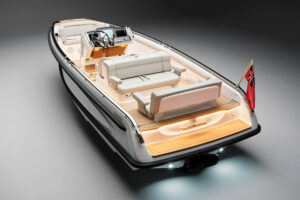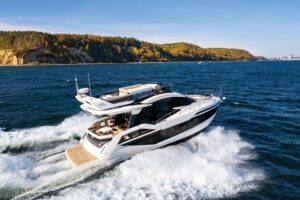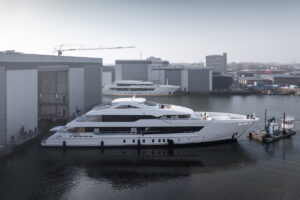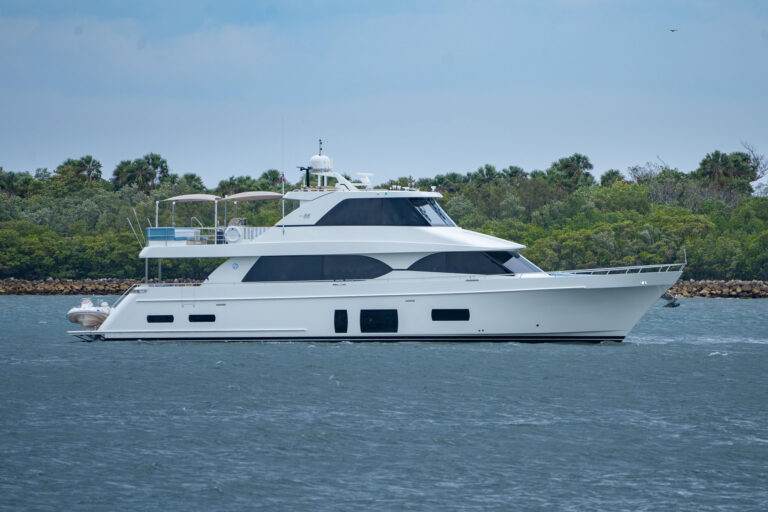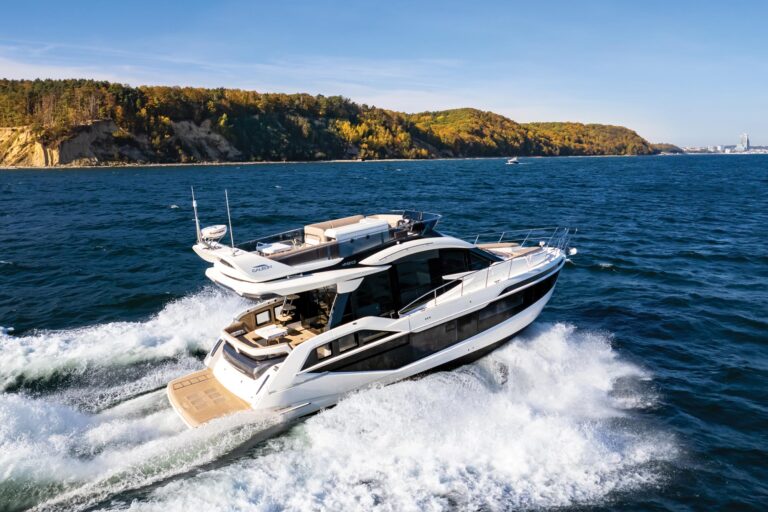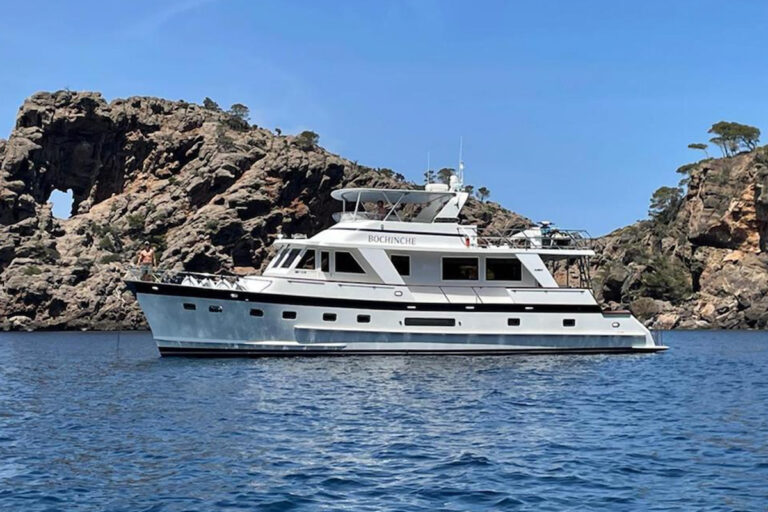Beneteau, the largest producer of recreational vessels in France and owner of a major boatbuilding plant in Marion, South Carolina, recently rolled out the Swift Trawler 42, its first trawler yacht-and the company’s first powerboat to reach the U.S. market. Beneteau is already well known on these shores for its wide and highly regarded range of sailboats, so it should come as no surprise that Beneteau’s entry into the U.S. power market is a strong one.
The Swift Trawler 42 makes a very positive impression. I particularly appreciated the ease of movement about the decks, possibly a carry-over from Beneteau’s extensive sailboat design experience. The interior space is very well used and avoids the negative impact of squeezing too much into a space. At anchor, she will be a very livable boat for a couple and occasional guests.
The Beneteau 42 can cruise all day at better then 20 knots without abusing her engines, structure or systems. The waterline beam, just under 14 feet, accounts in part for the ease with which the boat achieves her cruising speeds-it is somewhat smaller than what has become common of boats of this type. Whatever penalty the slightly narrow beam might have exacted on interior space and stowage is offset by Beneteau’s experience building sailboats, where every cubic inch is put to use.
The secret of this fast trawler lies in the builder’s combination of careful hull design, weight control and choice of efficient power plants. She is powered by twin 370 hp Yanmar six-cylinder turbo diesels and reaches a top speed in excess of 25 knots. Her hull has a sharp entry and maximum deadrise of 16 degrees, tapering to 12 at the transom. The yacht’s draft, only 3 feet, 5 inches, combines with props that are partly recessed into shallow hull tunnels, allowing practical access to thin waters.
High hull sides, combined with the upper-deck overhang, provide excellent protection for the side decks. The house is typical of modern trawler-yacht design, with large glass windscreens forward and fixed ports on the sides. The highly efficient aft cockpit has wing doors that close off the side decks. There are two hull bulwark doors: one on the transom for access to the swim platform, the other adjacent to the lower helm station’s sliding door. A welded stainless-steel rail surrounds the foredeck, with a sailboat-like lower security wire in the aft sections.
Beneteau designed the 42 with two staterooms forward, down a few steps from the saloon; access is via a small lobby at the foot of the steps. The master is far forward, and the guest is to starboard. The builder has taken pains to provide a high degree of sound isolation between the spaces.
The head/shower compartment on hull number two (the first available in the U.S.) was set up as two spaces. An MSD-equipped compartment is forward and entered through a door from the master, while a separate shower compartment is aft, entered from the lobby. A sliding door can separate the two areas. The builder has indicated an alternate layout will permanently separate the two compartments; each will have an MSD and a shower. The basic arrangement seems sensible for a boat usually occupied by a couple and occasional guests.
The lower helm station is to starboard. The engines are managed with single-lever controls. The trim tab and bowthruster controls are within easy reach. A comprehensive annunciator panel and full analog (round dial) instrumentation are provided for each engine. The upper part of the instrument panel provides adequate space for the usual array of electronics. The steering compass is properly placed, and I was pleased to note a placard on the door to the adjacent stowage locker warning that magnetic materials should not be placed there.
Opposite the helm is the galley. Here, the sink is forward of the sliding door to the side deck, and the stove and oven are just abaft the door. The refrigerator is hidden from view within nicely finished cabinetry.
Abaft the galley is the saloon. A long settee occupies the port side, and the dining table on our test boat was easy to move yet remained in place during high-speed runs and sharp, full-speed maneuvers. Access to the engine compartment is through a hinged, gas-spring-supported hatch on centerline at the after end of the saloon, just ahead of the sliding doors that provide access to the cockpit.
The cockpit is a delightful space. Four lockable hatches provide access to extensive stowage and to the 11kW Onan diesel genset. Wing doors close off the side decks to create a space that will be comfortable in almost all conditions, including when the 42 is cruising at immodest speeds. Side curtains are optional-they’re sure to be popular.
Construction includes the use of a cored hull with a bonded, load-bearing internal stringer system. The deck and superstructure are cored with balsa to provide a stiff, lightweight and sufficiently insulated structure. An internal molded-fiberglass liner contributes to strength and the trawler’s clean appearance.
Maximum displacement is 33,000 pounds, and fuel and fresh-water capacity are 395 and 169 gallons, respectively. Each of the two Yanmar 6LYA-STP six-cylinder turbocharged diesels delivers a maximum of 370 hp at 3300 rpm. The light weight of the engines-3.04 pounds per horsepower without marine gear-accounts for a significant part of the boat’s high-speed performance.
Though the company had not yet performed the final propeller tuning, we obtained a wide-open-throttle speed of 25.4 knots. Yanmar’s rating for these engines allows continuous operation at 3100 rpm-the maximum minus 200 rpm. Running the engines at this speed produced a reading of just over 23 knots on the GPS. More conservative skippers may choose to run their engines a bit slower-say, at 2900 rpm (a maximum sustained cruise-speed rating common to many engine manufacturers). At this rpm the engines were delivering only 75 percent of their rated power, yet the boat was cruising at 20.6 knots. The 42 is indeed a swift trawler.
At this power setting, we ran the boat into a 2-foot chop and 12 to 15 knots of wind on Tampa Bay and found the ride to be completely comfortable. The boat was stable and responded immediately to helm commands, including maximum-effort turns. Except in the turns off the wind, there was a notable lack of spray on the windscreens.
The ship’s electrical panel is aft on the port side and commendably small- unlike those that would be more appropriate at a major power-generating station. The skipper can conduct routine engine inspection without removing the saloon deck, but if needed, the sections can be removed for unobstructed access to all machinery. One small item in the engine compartment really delighted us: The sharp ends of the band-type hose clamps had slip-on plastic covers.
The primary fuel filters and seawater strainers for the engines are mounted on the after side of the fuel tanks, at the forward end of the engine compartment. At present, access to these critical service points requires passing between the engines. Though ventilation here is outstanding moving past all that hot iron is, at best, an unattractive idea.
The Beneteau Swift Trawler 42 balances the comfort of a sailboat interior, the efficiency of a slow-paced trawler and the quickness of a modern motoryacht. Anyone will find this well-done package tempting-even owners of the builder’s entries in the world of wind.
Contact: Beneteau USA, (843) 805-5000; www.beneteauusa.com. For more information, contact: (866) 922-4877; www.yachtingnet.com/yachting/productinfo.
Click here to read more about Beneteau yachts.

